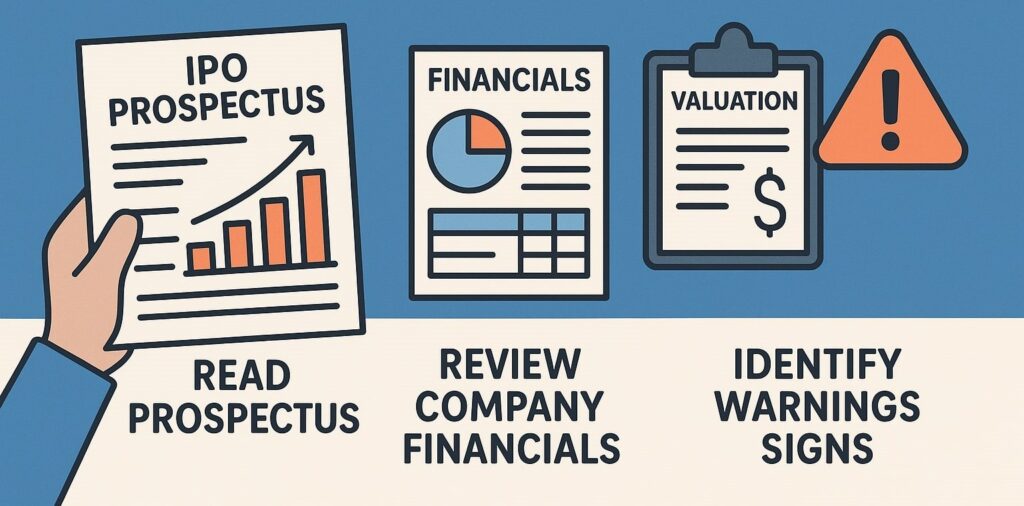Summary
Want to invest in an IPO but don’t know where to start? This beginner’s guide breaks down how to analyze an Initial Public Offering. Learn how to carefully read an IPO prospectus, review company financials, evaluate its valuation, and identify key warning signs to make smarter and more confident investment decisions.
Introduction
The world of Initial Public Offerings (IPOs) can be exciting. You hear about a new company going public, and there’s a lot of buzz about getting in on the ground floor. But how do you know if an IPO is a golden opportunity or a risky bet?
This guide is here to help you understand how to analyze an upcoming IPO in simple terms, so you can move from being a curious beginner to a confident investor.
What Is an IPO?
An IPO, or Initial Public Offering, is the very first time a private company makes its shares available for the public to buy. Think of it like a private club finally opening its doors to everyone. By selling shares, the company raises money to fund its growth, pay off debts, or expand its operations. For investors, it’s a chance to own a piece of the company early in its public journey.
Why Should You Analyze an IPO?
Not every company that goes public is destined for success. The hype around an IPO can sometimes be misleading. A thorough analysis helps you look past the noise and understand the real picture. It allows you to check if the business is fundamentally strong, if the share price is fair, and if the company has a real potential to grow in the future. Investing without analysis is just gambling.

Step-by-Step IPO Analysis for Beginners
Here’s a simple, step-by-step process to help you break down any IPO.
1. Read the IPO Prospectus (The Company’s Storybook)
What is a prospectus?
The prospectus, also known as the Red Herring Prospectus (RHP), is the most important document for any IPO investor. It’s an official, detailed book that tells you everything about the company, including its business model, financial health, potential risks, and exactly why it’s raising money.
What to look for:
- About the Company: What does the company actually do? How does it make money?
- Use of Funds: How will the company use the money it raises from the IPO? Look for productive uses like business expansion, new technology, or building factories. Be cautious if most of the money is going to pay off old debts or to early investors cashing out.
- Risks Involved: The company must list all potential risks to its business. Take a close look at this section to grasp the key challenges involved.
2. Check Company Financials
You don’t need to be an accountant, but you should look at the company’s financial health over the last 3-5 years.
Key metrics to check:
- Revenue: Is the company’s income growing steadily year after year?
- Net Profit: Is the company actually making a profit? Is the profit on the rise, or is it declining? A company with consistent profits is a good sign.
- Total Assets and Liabilities (Debt): Does the company have a lot of debt? Too much debt can be a burden, as profits will go towards paying interest instead of growing the business.
- Earnings Per Share (EPS): This shows how much profit the company makes for each share of its stock. A growing EPS is a positive signal.
Look for a track record of consistent growth, manageable debt, and healthy profit margins.
3. Analyze IPO Pricing & Valuation
What is valuation?
Valuation tells you how much the company is worth based on the IPO price. Just because a company is good doesn’t mean its shares are a good buy at any price.
Tips:
- Compare the Price-to-Earnings (P/E) ratio with similar, already-listed companies. The P/E ratio shows whether you’re paying too much or getting a good deal for the company’s earnings. If a company’s P/E is 30, it means you are paying ₹30 for every ₹1 of its annual earnings. Is that high or low compared to its competitors?
- Avoid wildly overvalued IPOs. If a company is priced too high, its stock price may fall after listing as the hype cools down.
4. Understand the Industry & Competitors
A great company in a failing industry will struggle. Ask yourself:
- Is the company dominating its industry or just starting to make a name?
- How tough is the competition? Is it easy for new companies to enter and disrupt the market?
- Is the industry itself growing? (e.g., sectors like renewable energy, fintech, or specialized healthcare are often seen as high-growth areas).
5. Review Management Quality
The people running the company are just as important as the business itself.
- Look up the background and track record of the company’s founders and top executives (CEO, CFO).
- Do they have deep experience in their industry? Strong, experienced, and trustworthy leadership is a huge plus.
6. Check Grey Market Premium (GMP) & Investor Demand
The Grey Market Premium (GMP) is an unofficial indicator of investor interest before the IPO lists on the stock exchange. It gives you an estimate of what the stock could list at..
- High GMP can suggest strong demand and potentially a good listing day. However, do not rely on GMP alone. It can be volatile and change quickly.
- Check the subscription numbers to see how much demand there is from different types of investors (retail, institutional).
You can easily track the latest GMP and subscription figures for upcoming IPOs on dedicated platforms like the IPOCornerr website or its mobile apps.
7. Look at Lock-In Periods & Shareholder Info
Are the main shareholders and promoters (the founders/owners) locked in, or can they sell their shares right after the IPO?
- A lock-in period means promoters and big investors cannot sell their shares for a certain amount of time. This shows they are committed to the company’s long-term future and increases investor confidence.
Sample Checklist: Quick IPO Analysis Guide
| Step | Key Action Points |
| Prospectus Review | Read the company overview, how funds will be used, and key risks. |
| Financial Check | Analyze revenue growth, profit trends, and debt levels. |
| Price Valuation | Compare the IPO’s P/E ratio with industry peers to check for overpricing. |
| Industry Analysis | Study the competition, market trends, and growth opportunities. |
| Management Quality | Research the experience and reputation of founders and leadership. |
| GMP & Demand | Check grey market trends and investor subscription numbers for sentiment. |
| Lock-in Details | See if promoters are committed for the long term. |
Red Flags to Watch Out For
- Sudden Revenue or Profit Spike: A huge, unnatural jump in profits right before the IPO could be a sign of “window dressing” to make the financials look better than they are.
- High Levels of Debt: If a company is drowning in debt, its future profits may be used to pay off lenders instead of growing the business.
- Complex or Unclear Business Model: If you read the prospectus and still can’t explain what the company does in a simple sentence, be cautious.
- Promoters Reducing Their Stake: If the original owners are selling a large portion of their shares in the IPO, it might mean they don’t see much growth left.

Final Tips for Beginners
- Never base your investment decisions purely on hype, social media buzz, or tips from friends. Always do your own research.
- Stay informed with dedicated IPO-tracking platforms. IPOCornerr provides all the essential data in one place – from GMP and subscription numbers to allotment status and expert reviews.
- Consider investing a small amount if you are a beginner or are unsure about an IPO. It’s a great way to learn without taking a big risk.
Monitor IPOs on the go with the IPOCornerr app:
- Download for Apple: https://apps.apple.com/in/app/ipocornerr/id6747035013
- Download for Android: https://play.google.com/store/apps/details?id=com.ipocornerr
FAQs
What is IPO analysis?
IPO analysis is the process of thoroughly reviewing a company’s financials, business model, management quality, valuation, and industry position before deciding whether to invest in its Initial Public Offering.
What’s the best way to choose an IPO to invest in?
Look for a combination of factors: strong and consistent financial growth, a clear business strategy, experienced leadership, a growing industry, and a realistic IPO price that isn’t overvalued compared to its peers.
Where to check IPO allotment and listing?
You can verify your allotment status on the official registrar’s site. For a more convenient experience, you can use trusted IPO tracking apps like IPOCornerr or visit financial news sites, which consolidate this information for you.
With this beginner’s guide, you are now better prepared to analyze IPOs, spot genuine opportunities, and avoid costly mistakes. Start your IPO investing journey with confidence